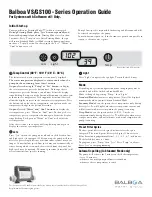
8
NOTE
•
Use a pipe cutter and flare suitable for R410A.
•
Use a piping branch kit selected based on the selection procedure for refrigerant branch kits.
•
See the installation manual for the outdoor unit and other relevant technical documents for details on refrig-
erant branch kit selection, maximum piping length, maximum height difference, and maximum length after
branch.
•
Apply ether oil or ester oil around the flare portions before connecting.
•
Only use the flare nuts attached with the unit. Using different flare nuts may cause the refrigerant to leak.
•
To prevent dust, moisture or other foreign matter from infiltrating the tube, either pinch the end or cover it
with tape.
•
The outdoor unit is charged with refrigerant.
•
Be sure to use both a spanner and torque wrench together when connecting or disconnecting pipes to/from
the unit.
(Refer to Fig. 1)
•
When connecting the flare nut, coat the flare both inside and outside with refrigerating machine oil and ini-
tially tighten by hand 3 or 4 turns.
(Refer to Fig. 2)
•
Refer to the Table 1 for the measurements of tightening torque and flare. Overtightening may damage the flare.
•
Refer to Table 2 if no torque wrench is available.
Using a wrench to tighten flare nuts causes the tightening torque to suddenly grow much tighter after a certain
point. From there, tighten the nut further by the appropriate angle listed in Table 2. After this is done, make sure
no gas is leaking.
•
When brazing the refrigerant piping, perform nitrogen replacement (note 1) first or perform the brazing
(note 3) while feeding nitrogen into the refrigerant piping (note 2), and finally connect the indoor unit and BS
unit using the flare or flange connections.
Notes
1 For details on nitrogen replacement, see the “VRV Installation Manual” (available at any Daikin dealer).
2 When feeding nitrogen into the pipes while brazing, the pressure-reducting valve should be set to
2.9psi.
(Refer to Fig. 4)
3 Do not use a flux when brazing the refrigerant pipe joints.
Use phosphor copper brazing (BCuP) which does not require flux.
(Using a chlorine flux may cause the pipes to corrode, and if it contains fluoride it may cause the refrig-
erant lubricant to deteriorate, adversely affecting the refrigerant piping system.)
•
Piping connections should be checked for gas leaks and then, referring to Fig. 3, insulated using the included
joint insulating material 3) on all liquid and gas pipes (a total of 5 locations)
(Tighten both edges with clamp 2).) Use the included joint insulating material.
•
For locally procured insulation, be sure to insulate all the way to the pipe connections inside the machine.
Exposed piping may cause condensation to form or burns on contact.
•
Use the following material specification for refrigerant piping:
(1) construction material: Phosphoric acid deoxidized seamless copper for refrigerant.
(2) size: Determine the proper size referring to chapter “SELECTION OF PIPE CONNECTION SIZE”
(3) The wall thickness of the refrigerant piping should comply with relevant local and national regulatoins.
•
Ventilate if refrigerant gas leaks while performing work.
•
Finally make sure there is no refrigerant gas leak. A toxic gas may be released by the refrigerant gas leak-
ing indoor and being exposed to flames from an area heater, cooking stove, etc.



































